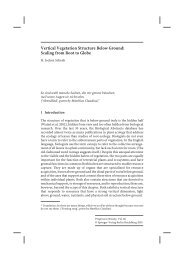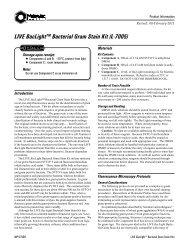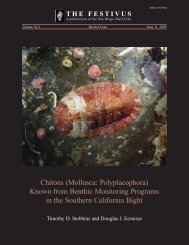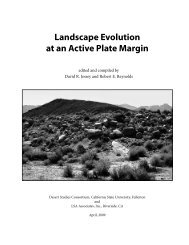2010 Overboard in the Mojave - Biological Science - California State ...
2010 Overboard in the Mojave - Biological Science - California State ...
2010 Overboard in the Mojave - Biological Science - California State ...
You also want an ePaper? Increase the reach of your titles
YUMPU automatically turns print PDFs into web optimized ePapers that Google loves.
Stratigraphy and paleontology of <strong>the</strong><br />
middle to late Pleistocene Manix Formation,<br />
and paleoenvironments of <strong>the</strong><br />
central <strong>Mojave</strong> River, sou<strong>the</strong>rn <strong>California</strong><br />
__________<br />
George T. Jefferson<br />
Colorado Desert District Stout Research Center, Anza-Borrego Desert <strong>State</strong> Park<br />
200 Palm Canyon Drive, Borrego Spr<strong>in</strong>gs, <strong>California</strong> 92004, gjefferson@parks.ca.gov<br />
Abstract<br />
The Manix Formation consists of lacustr<strong>in</strong>e, fluvial and alluvial sediments that<br />
were deposited with<strong>in</strong> and adjacent to Lake Manix. This middle to late Pleistocene<br />
pluvial lake was probably <strong>the</strong> largest along <strong>the</strong> <strong>Mojave</strong> River dra<strong>in</strong>age system, which<br />
heads <strong>in</strong> <strong>the</strong> Transverse Ranges of sou<strong>the</strong>rn <strong>California</strong> and runs nor<strong>the</strong>ast to Death<br />
Valley. Dur<strong>in</strong>g high lake stands, <strong>the</strong> lake covered ~236 km 2 of <strong>the</strong> central <strong>Mojave</strong><br />
Desert. Lake Manix deposits record much of <strong>the</strong> early hydrological history of <strong>the</strong><br />
upper <strong>Mojave</strong> River.<br />
Atta<strong>in</strong><strong>in</strong>g an exposed thickness of ~40 m, <strong>the</strong> Manix Formation overlies playa<br />
lake deposits of <strong>the</strong> Pliocene-Pleistocene <strong>Mojave</strong> River Formation, and is locally<br />
overla<strong>in</strong> by latest Pleistocene and Holocene fluvial deposits. The Manix Formation<br />
is mappable as four laterally equivalent members. Generally from oldest to youngest<br />
<strong>the</strong>se were deposited as: bas<strong>in</strong> marg<strong>in</strong> fanglomerates, alluvial and fluvial deposits,<br />
lacustr<strong>in</strong>e and paralimnic deposits, and fluvial/deltaic deposits. The <strong>in</strong>terf<strong>in</strong>ger<strong>in</strong>g<br />
relationships of <strong>the</strong>se sediments, especially between <strong>the</strong> lacustr<strong>in</strong>e and fluvial<br />
systems, documents at least four major transgressive/regressive lacustr<strong>in</strong>e events<br />
with<strong>in</strong> <strong>the</strong> last 0.5 m.y. Transgressive lacustr<strong>in</strong>e events are <strong>in</strong> phase with relatively<br />
cool/moist regional climatic conditions <strong>in</strong>ferred to be present dur<strong>in</strong>g even-numbered<br />
mar<strong>in</strong>e oxygen isotope stages. The chronology of <strong>the</strong>se deposits is relatively<br />
well constra<strong>in</strong>ed by paleomagnetic data, U/Th series ages, tephra chronology, and<br />
14 C ages.<br />
Molluscan, ostracode, and aquatic and terrestrial vertebrate assemblages have been<br />
recovered primarily from <strong>the</strong> fluvial, paralimnic and lacustr<strong>in</strong>e deposits with<strong>in</strong> <strong>the</strong><br />
formation. Included are 55 taxa of fossil vertebrates that range between 350+ ka and<br />
ca. 20 ka, spann<strong>in</strong>g possibly late Irv<strong>in</strong>gtonian through late Rancholabrean North<br />
American Land Mammal Ages. The assemblage comprises ext<strong>in</strong>ct and extralocal<br />
extant taxa that reflect climatic and biogeographic conditions dramatically different<br />
from <strong>the</strong> present xeric environment.<br />
from Jefferson, G.T., 2003, Stratigraphy and paleontology of <strong>the</strong> middle to late Pleistocene Manix Formation, and<br />
paleoenvironments of <strong>the</strong> central <strong>Mojave</strong> River, sou<strong>the</strong>rn <strong>California</strong>, <strong>in</strong> Enzel, Y., Wells, S.G., and Lancaster, N., eds.,<br />
Paleoenvironments and paleohydrology of <strong>the</strong> <strong>Mojave</strong> and sou<strong>the</strong>rn Great Bas<strong>in</strong> Deserts: Boulder, Colorado, Geological<br />
Society of America Special Paper 368, p. 43-60. © 2003 Geological Society of America.<br />
38 <strong>2010</strong> Desert Symposium
















